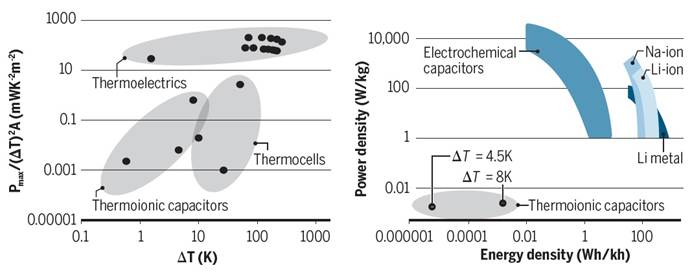Researchers Clarify the Performance Discrepancies among Thermoelectrics, Thermoionic Capacitors and Thermocells
Heat is ubiquitous; in fact, more than half of the energy generated by mankind ends up in the form of waste heat. Harvesting and directly converting waste heat to electricity thus have immense economic, environmental and technical impacts. Even termed “waste”, heat has grades. The environmental heat, human body heat, and heat with a temperature difference on the order of 1-10 K constitute “low-grade heat”, which is very hard to harvest. On the other hand, harvesting low-grade heat is crucial for the efficiency of energy conversion and for the betterment of human being’s life. The breakthroughs in the low-grade heat harvesting technology shall profoundly alter the landscape of information technology, medical and health industry to name a few.
In a perspective paper entitled "Thermopower and harvesting heat—A metric to compare low-grade heat–to–electricity conversion can be misleading," published in Science on Jan. 22, Dr. SHI Xun from Shanghai Institute of Ceramics, Chinese Academy of Sciences and Dr. HE Jian from Clemson University, USA clarified the confusion, addressed the connections among and distinctions between thermoelectrics, thermoionic capacitors and thermocells, and compared the performance of the said technologies.
Thermoelectrics, thermoionic capacitors, and thermocells are the trio front runners among the state-of-the-art low-grade heat harvesting technologies. Despite distinct working principles, the said technologies are “heat engines” in a general sense as they all convert a temperature difference DT to a device voltage output DVD that drives the electrons in the external circuit to do work.
As the unit of the (DVD/DT) ratio is same as the thermopower, a common pitfall in research is to confuse the (DVD/DT) ratio, a numeric performance index of device, with the thermopower (DVD/DT) ratio, an intrinsic material property. The confusion has led to certain faulty claims of “ultrahigh” thermopower and improper comparisons between the performance of thermoelectrics, thermoionic capacitors, and thermocells.
The performance discrepancies highlight where the research challenges and opportunities lie in the future development of low-grade heat harvesting technologies.

Differences in temperature can be used to drive current with a variety of different devices. Thermo- electrics rely on a p-type and an n-type material that drives electrons (e) or holes (h) from source to sink. Thermoionic capacitors rely on separation of positive from negative ions. Themocells require temperature difference-specific ion and electron cycling. The relative effectiveness of these devices requires care when comparing performance metrics.

The normalized power density as a function of the temperature difference (left panel) shows the relative difference in performance between the device types. The power density versus energy density plot (right panel) shows the difference between thermionic capacitors and other methods of storing energy. Black dots: experimental measurements.
Reference:
https://science.sciencemag.org/content/371/6527/343
Contact:
Dr. SHI Xun
Shanghai Institute of Ceramics
Email: xshi@mail.sic.ac.cn



